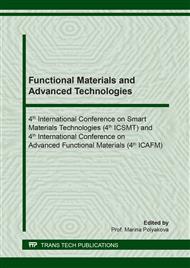p.98
p.103
p.110
p.115
p.120
p.127
p.132
p.141
p.148
Enhanced Electromagnetic Wave Shielding Effectiveness of Carbon-Based Nonwoven Fabrics by H2 Plasma Treatment
Abstract:
Electromagnetic wave shielding effectiveness of the nonwoven fabrics was measured in the wide operating frequency range, namely 0.4GHz to 20GHz. The shielding effectiveness of the nonwoven fabric was below 45dB in the range of 0.04GHz to 15GHz and then it increased to above 45dB in the range of 15GHz to 20GHz. To enhance the electromagnetic wave shielding effectiveness of the nonwoven fabrics, 3 minutes H2 plasma treatment of the nonwoven fabrics was carried out under the microwave plasma-enhanced chemical vapor deposition system. By H2 plasma treatment, the shielding effectiveness of the nonwoven fabrics was greatly enhanced in the whole operating frequency range. The surface electron conductivity of the nonwoven fabrics was also enhanced from 2.11×103 S/m to 3.02×103S/m by H2 plasma treatment. The surface and cross sectional morphologies of the nonwoven fabrics with or without H2 plasma treatment were investigated and compared with each other. Crystal structure variation of the nonwoven fabrics by H2 plasma treatment was also investigated. Based on these results, the cause for the enhancement of the shielding effectiveness of the nonwoven fabrics by H2 plasma treatment was suggested and discussed.
Info:
Periodical:
Pages:
120-126
Citation:
Online since:
March 2020
Authors:
Price:
Сopyright:
© 2020 Trans Tech Publications Ltd. All Rights Reserved
Share:
Citation:


